PLEASE NOTE: This is the Archived Sexyloops Board from years 2004-2013.
Our active community is here: https://www.sexyloops.co.uk/theboard/
Our active community is here: https://www.sexyloops.co.uk/theboard/
loop + line speed - due to pullback
- Bernd
- IB3 Member Level 1
- Posts: 2204
- Joined: Sat Mar 11, 2006 10:55 pm
- Location: Hamburg, Germany
- Contact:
I don't see much acceleration there. Ok, the path for the tip is quiet some longer since it "waves" in different directions. So it has to be little faster than the section before. But I do not yet see how that small accel. would be linked to the change in momentum and the conservation of momentum principle? I doubt we would not see almost the same speed with a non tapered line? But I don't know of course.
Bernd Ziesche
www.first-cast.de
www.first-cast.de
-
gordonjudd
- IB3 Member Level 1
- Posts: 2214
- Joined: Mon Jul 10, 2006 12:14 am
- Location: California
- Contact:
-
gordonjudd
- IB3 Member Level 1
- Posts: 2214
- Joined: Mon Jul 10, 2006 12:14 am
- Location: California
- Contact:
Wouldn't tapering slow down the unrolling???
Bernd,
Let's all repeat:
The moving mass in a fly wave is much different than the moving mass in a whip wave.
Thus concepts such as the conservation of momentum which can be reasonably applied to a whip wave do not apply to a fly wave. It also means that the effects of taper are much different for a whip wave as compared to a fly wave.
It is unfortunate that a fly wave has been assumed to have the same physics as a a bull whip in most of the fly casting books you have read, but applying concepts such as conservation of momentum or conservation of energy do not apply when external forces are acting on a system.
I hope some of the stuff I sent you will help you to understand why the impact of the taper in a fly line is much different than the effect that taper has on a whip.
Like the "big spring" theory I think the "bull whip" analogy will take a long time to change in fly casting literature. To bad physics teachers are not better casters. If they were writing casting books we would have a much better understanding of what is really going on.
In Tom's video we could see that if the rod-leg has the same (negative) acceleration than the fly-leg has (positive), the loop will not move but kind of be "frozen".
The correct comparison to determine the velocity of the loop is the relative velocity (not acceleration) of the rod leg relative to the fly leg. If they are equal and opposite then the loop velocity will be frozen.
During pull back while the loop is propagating the velocity of the pull back is likely to increase the fly velocity while slowing down the loop velocity.
The added tension that comes from pull back or a sharp haul while the loop is being formed is not understood (at least by me.) I like Mac's observation that there is some "magic" going on there, and is much more complicated than just adding velocities.
I expect that Dr. Gatti-Bono has modeled what is going on during loop formation, but six equations with six unknowns is beyond my simple comprehension.
Gordy
"Flyfishing: 200 years of tradition unencumbered by progress." Ralph Cutter
- Bernd
- IB3 Member Level 1
- Posts: 2204
- Joined: Sat Mar 11, 2006 10:55 pm
- Location: Hamburg, Germany
- Contact:
Thanks Gordy!
If for the bull whip we assume "no air resistance" cause it is that low based on the higher density of the bull whip material than wouldn't that mean the conservation of momentum pronciple should match here?
The problem I have is: The taper for the bull whip is HUGE but the acceler. of the cracker-leg (if there is some) is low looking at those slmo video.
So I do not see how the "decrease in mass = increasein velocity" fits here?
From the casting perspective I can tell that adding a short pull back in the beginning of loop formation results in a serious increase in line tension for the unrolled line.
I think we need a slomo of this to see what the speed (velocity) does exactly.
Will keep that in mind!
If for the bull whip we assume "no air resistance" cause it is that low based on the higher density of the bull whip material than wouldn't that mean the conservation of momentum pronciple should match here?
The problem I have is: The taper for the bull whip is HUGE but the acceler. of the cracker-leg (if there is some) is low looking at those slmo video.
So I do not see how the "decrease in mass = increasein velocity" fits here?
From the casting perspective I can tell that adding a short pull back in the beginning of loop formation results in a serious increase in line tension for the unrolled line.
I think we need a slomo of this to see what the speed (velocity) does exactly.
Will keep that in mind!
Bernd Ziesche
www.first-cast.de
www.first-cast.de
-
gordonjudd
- IB3 Member Level 1
- Posts: 2214
- Joined: Mon Jul 10, 2006 12:14 am
- Location: California
- Contact:
that mean the conservation of momentum pronciple should apply to a whip wave?
Bernd,
That is correct but you have assume the shape of the whip wave will also change as it propagates so it will satisfy the conservation of energy. Goriely did not include any drag effects in his whip wave paper, but did use the conservation of momentum as one of his many governing equations.
The problem I have is: The taper for the bull whip is HUGE but the acceleration. of the cracker-leg (if there is some) is low looking at those slo-mo videos.
You cannot see the velocity increase in the cracker in those videos since it is so small.
However I think the measured acceleration rates of the cotton threads used in this investigation did have very large acceleration values as they flipped over and cracked. They note:
Note the great increase in speed from the 3rd to the 4th flash. This is evidence of the tremendous acceleration that the tip must undergo if it is to reach supersonic speeds.
Gordy
"Flyfishing: 200 years of tradition unencumbered by progress." Ralph Cutter
-
gordonjudd
- IB3 Member Level 1
- Posts: 2214
- Joined: Mon Jul 10, 2006 12:14 am
- Location: California
- Contact:
From the casting perspective I can tell that adding a short pull back in the beginning of loop formation results in a serious increase in line tension for the unrolled line.
and
I think we need a slomo of this to see what the speed (velocity) does exactly.
Bernd,
That would be interesting, but understanding how the force from the haul impacts the loop velocity is not going to be solved by anyone here.
As complicated as Dr. Gatti-Bono's analysis of loop formation was as shown below:
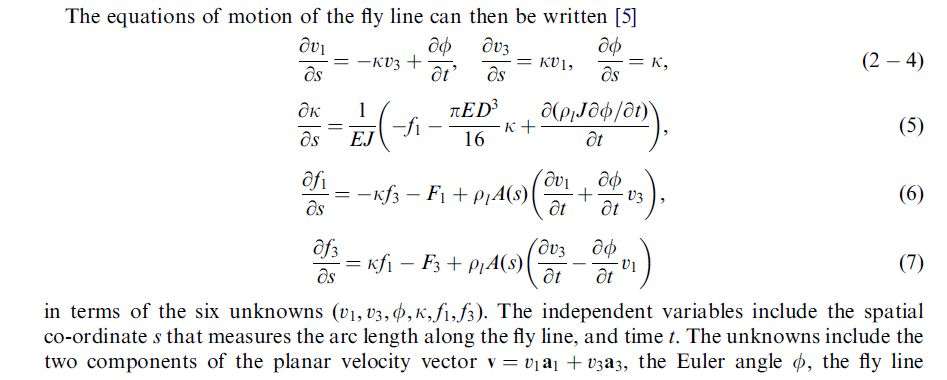
it did not include any externally applied hauling forces. That will have to wait for another brilliant PhD student of Dr. Perkins to solve.
Gordy
"Flyfishing: 200 years of tradition unencumbered by progress." Ralph Cutter
- Bernd
- IB3 Member Level 1
- Posts: 2204
- Joined: Sat Mar 11, 2006 10:55 pm
- Location: Hamburg, Germany
- Contact:
Gordy,gordonjudd wrote:You cannot see the velocity increase in the cracker in those videos since it is so small.The problem I have is: The taper for the bull whip is HUGE but the acceler. of the cracker-leg (if there is some) is low looking at those slo-mo videos.
I have no doubt the cracker will accelerate like hell... Pretty obious it hits sound barrier.
But if the cracker-leg reduces it's mass about let's say 80% then it's velocity should increase about 80%, right?
If there are no drags to be taken into account then I should the cracker-leg see increasing it's velocity way before the cracker goes to change it's direction?
And this is not what I see. All I see is that the speed up happens for the very last part of unrolling when the initial mass of the cracker-leg already has decreased about 95?%
Bernd Ziesche
www.first-cast.de
www.first-cast.de
-
gordonjudd
- IB3 Member Level 1
- Posts: 2214
- Joined: Mon Jul 10, 2006 12:14 am
- Location: California
- Contact:
And this is not what I see. All I see is that the speed up happens for the very last part of unrolling when the initial mass of the cracker-leg already has decreased about 95?%
Bernd,
What pictures or video are you talking about here?
The mass density of the threads in a cracker are quite small, so they are going to have some significant negative acceleration from drag when the velocity starts increasing suddenly. Thus it was not easy to get them to crack, even though a simple conservation of momentum concept would assume the velocity would approach infinity as the moving mass in the unrolling loop approach zero.
However, because of drag forces the velocity is never going to approach infinity near the time of the crack as a simple momentum conservation analysis would predict.
The other thing you can see from their videos is that the ends of the cracker are always moving, thus the amount of moving mass never goes to zero either. That will limit the ultimate velocity of the ends as well.
Here is a picture taken from that towel cracking paper that shows the speed up of the threads in their cracker as they exceeded the sound barrier of 345 m/s.

Is the flip-over velocity they measured what you are talking about?
Gordy
"Flyfishing: 200 years of tradition unencumbered by progress." Ralph Cutter
- Bernd
- IB3 Member Level 1
- Posts: 2204
- Joined: Sat Mar 11, 2006 10:55 pm
- Location: Hamburg, Germany
- Contact:
http://dsc.discovery.com/videos/time-warp-bullwhip.html
If I stop at 00:16 there is almost the whole cracker-leg (top-leg) gone - so it's mass hasdecreased about 95%, but it's velocity seems to be almost the same like in the beginning.
That is what I see in fly casts, too.
If I stop at 00:16 there is almost the whole cracker-leg (top-leg) gone - so it's mass hasdecreased about 95%, but it's velocity seems to be almost the same like in the beginning.
That is what I see in fly casts, too.
Bernd Ziesche
www.first-cast.de
www.first-cast.de
-
gordonjudd
- IB3 Member Level 1
- Posts: 2214
- Joined: Mon Jul 10, 2006 12:14 am
- Location: California
- Contact:
If I stop at 00:16 there is almost the whole cracker-leg (top-leg) gone - so it's mass hasdecreased about 95%, but it's velocity seems to be almost the same like in the beginning.
Bernd,
I don't think you can even see the cracker in that video, let alone measure its velocity.
What you are saying probably applies to the end of fall (that you can see) where it is attached to cracker, but you need photos such as the ones using high speed strobes to see what the ends of the cracker are doing.
That was not very easy to do either, and having a strobe speed of 4000 fps was not sufficient to track the ends of threads at the moment of the crack. Thus they had some uncertainty in how far the end moved between the two frames since they did not have enough resolution to track its actual path.
Gordy
"Flyfishing: 200 years of tradition unencumbered by progress." Ralph Cutter
- Bernd
- IB3 Member Level 1
- Posts: 2204
- Joined: Sat Mar 11, 2006 10:55 pm
- Location: Hamburg, Germany
- Contact:
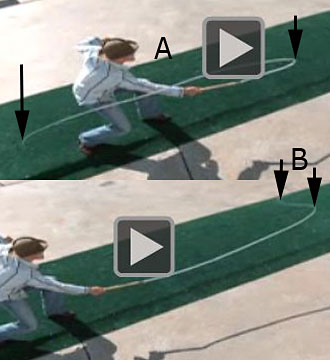
The first picture shows the whole cracker-leg (top-leg) A being 7 times the length that it (B) has in the bottom picture.
Since there is a huge tapering the mass decrease in the top-leg from picture 1 to 2 should be huge (95%?).
But the velocity of the top-leg is still the same as it was in the beginning.
Following the conservation of momentum the decrease in mass from pic 1 to pic 2 should increase the velocity of the top-leg about a huge amount!?
Am not talking about what ahppens later on when the cracker breaks the sound barrier. That happens later.... of course. And I know that I cannot see that in detail.
Bernd Ziesche
www.first-cast.de
www.first-cast.de
-
gordonjudd
- IB3 Member Level 1
- Posts: 2214
- Joined: Mon Jul 10, 2006 12:14 am
- Location: California
- Contact:
Following the conservation of momentum the decrease in mass from pic 1 to pic 2 should increase the velocity of the top-leg about a huge amount!?
Bernd,
If we assume there are no drag losses and the relative amount of moving mass in the second photo is .1 (to take into account the taper of the whip) of the mass in the first photo then the conservation of momentum would say the velocity of the moving mass would be 10 times the velocity of the moving mass in the first photo.
However, that would violate the conservation of energy since 1/2 m1*v1^2<1/2*.1*m1*(10*v1).^2. Thus momentum is not conserved in this case since he was using a fly wave rather than a whip wave to produce a crack in that video. Consequently we need to look at the problem using energy considerations as Hendry did for the fly loop shape since that is the wave shape he used in that video.
Dr. Gatti-Bono looked at the energy considerations for a level line with no drag losses and found that:

She computes the beta value as being equal to:

Assuming the diameter of the whip at its mid point was .015 m, the mass density of the whip was 2500 kg/m^3, the radius was .1 m and the mass of the thong and cracker was 1% of the mass of the whip I get a computed beta factor of .33.
Plugging that into her velocity equation assuming the length of of the cracker leg in photo #2 was .1 the initial 2.5 meter length of the fall of the whip I get an expect velocity of the cracker in the second photo as being
v2=sqrt(2.5-.33/(.25+.33))*v1 or
v2=1.9*v1.
You would expect the relative velocity of the loop to also increase by that relative factor of 1.9.
Have you been able to use Tracker to compute the actual loop velocity values? The length of the whip is foreshortened by the camera angle in that video and thus the real velocity will be greater than the one given by tracker. But I would think you could get an approximate value for the real relative value using a photographic correction for that shortening effect.
If the measured increase is much less than a factor of 2, then that would say the drag forces on the whip cannot be neglected, and you would have to use the work-energy analysis of Hendry's to get a better estimate for the actual cracker velocity history.
At any rate you cannot use a simple conservation of momentum approach since that does not fit with the energy constraints imposed by the fly wave shape that was used to crack the bull whip in that video.
Am not talking about what happens later on when the cracker breaks the sound barrier.
Sorry for not understanding the point you were trying to get across. I read "cracker-leg" but was thinking "cracker". I do better with pictures than I do with words.
You have a valid observation, but it is tricky to get good velocity estimates when the video camera is not orthogonal to the propagation direction.
You can get an idea of how big an error non-orthogonal camera angles can produce by looking at the computed length of the length of the whip in your two frame grabs.
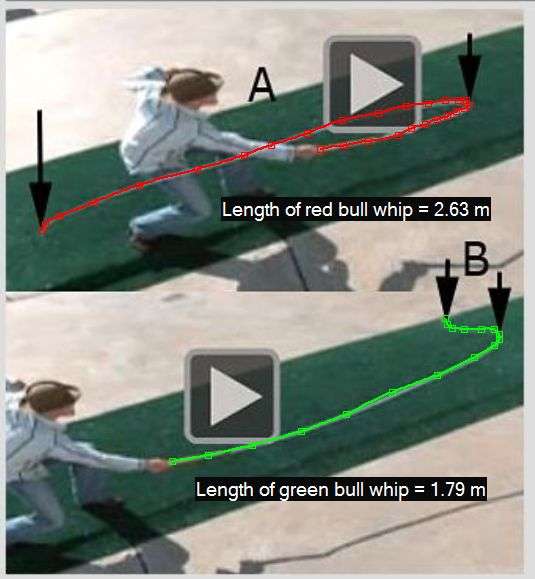
Using the same pixel to meter scale factor in both images the apparent length of the whip in photo #2 is only 68% of the length in photo #1 where more of the whip was closer to the camera. That means the velocity you get for an object that is further away from the camera will be less than it actually is.
Gordy
"Flyfishing: 200 years of tradition unencumbered by progress." Ralph Cutter
- Paul Arden
- Fly God 2010
- Posts: 23925
- Joined: Sat Jul 26, 2003 10:35 am
- Location: Travelling
- Contact:
-
gordonjudd
- IB3 Member Level 1
- Posts: 2214
- Joined: Mon Jul 10, 2006 12:14 am
- Location: California
- Contact:
I did several times, the extracts on the board do not give this information.
Vince,
If that is the case maybe you did not find the post that included Hendry's derivation of the acceleration force on the top leg assuming that the KE of its moving mass was constant.
His detailed development of that derivation is in this post. He assumed that with no drag losses the KE of the moving mass in the rod leg would be constant as the length of the top leg shortened. Using the chain rule for the derivative of the KE that involves changes in both the velocity an magnitude of the moving mass he showed that the acceleration of the moving mass for the top leg of the loop would be:

Newton's second law would predict that same acceleration force would be equal to F=dp/dt.
It never hurts to check however, but I was not able to come up a closed form expression for the derivative of the momentum. Dr. Gatti-Bono derived an expression that shows how the fly velocity would vary as a function of the length of the top leg as given in post 102, but did not give a result for the velocity and mass changes vs time.
Thus I used numerical techniques to come up with a comparison of Hendry's F=rho_l*(v_fly/2).^2 equation with the value predicted by Newton. The velocity and mass variations vs time relations required for that computation were derived using an ODE to compute the expected fly position and its velocity for a 20 meter 8 weight floating line having an initial fly velocity of 40 m/s. As noted by Hendry this did not include the effects of the moving mass in the loop to simplify the complexity of the ODE. That would be equivalent to setting Dr. Gatti-Bono's beta factor to zero.
The resulting fly velocity history and amount of moving mass in the top leg for that case of drag free propagation are shown below. I stopped the ODE when the length of line remaining in the top leg was 1 m to avoid the blow up of the velocity for smaller moving mass values.
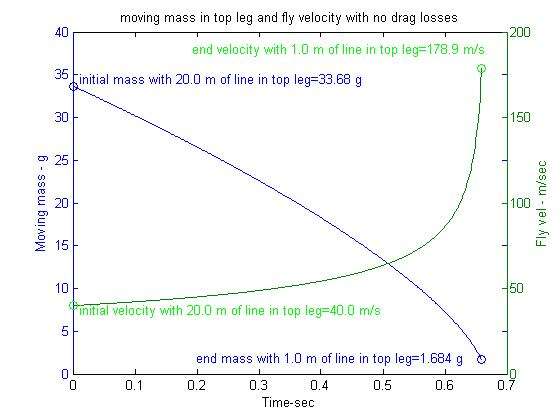
It was unknown to me, but the reference in the Wikipedia article on variable mass systems finds that in our case the acceleration force for a system with a reducing mass is:
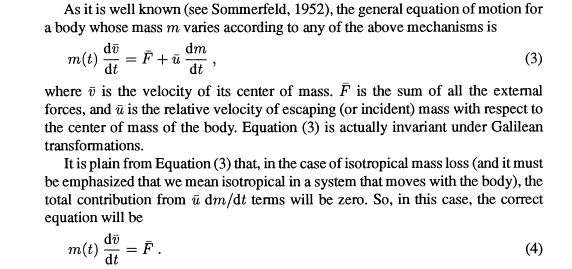
Taking the derivative of the velocity and multiplying by the moving mass gives the magnitude of the acceleration force (F=m(t)*dv/dt) curve as a function of time as shown below.
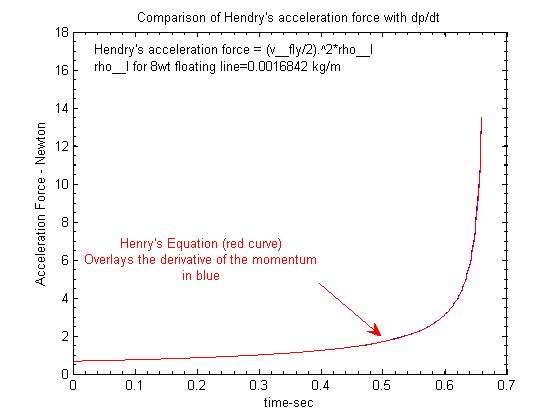
Overlay-ed on that plot (which was plotted in blue) is the plot of Hendry's equation that was plotted in red. Those values were nearly identical (although you can see a few blue pixels in some places), so it appears Newton and Hendry come up with the same acceleration force values.
Gordy
"Flyfishing: 200 years of tradition unencumbered by progress." Ralph Cutter
Who is online
Users browsing this forum: No registered users and 2 guests


